Where does UX design fit in?
So you’ve got an existing website or application that might need some changes, or you’re embarking on a project to create a new one.
Of course, you’ll be aiming to create a good user experience while meeting your business objectives (who wouldn’t?). You probably have a (very valid) set of ideas about what your users or customers need and how to best go about meeting those needs on your site. But how can you be sure that your users think the way you think they do? …What might have been missed? In short – how can you be sure you’re on the right path before you invest heavily and commit major resources to building the solution?
This is where User Experience (UX) comes in. The umbrella term ‘user experience’ covers a range of disciplines and roles – from strategy and research to design, prototyping and testing – with the label of UX Designer generally applying to anyone engaged in crafting a better fundamental user experience.
UX Designers are often considered part of the ‘creative’ team on a website build, but there’s plenty of science and logic behind what we do and why we do it – taking into account cognitive bias (emotional decision making processes and traits), usability conventions based on thousands of research studies and quantitative as well as qualitative data synthesis. What this means in practical terms, is that a UX Designer will help uncover more context about what your users need and how they might think. They’ll guide the solution towards making customer interactions with you as friction-free as possible while driving your business goals forward and, importantly, engage stakeholders with storytelling that brings everyone along for the ride. Good UX is much more than subjective creativity, and can be justified very easily in terms of quantifiable return on investment (ROI).
When should I engage a UX Designer?
The short answer is, the earlier you can apply sound UX thinking to your project, the better.
At the outset of a new website or app project
Before any solution or features are even outlined, a UX Designer can help facilitate discovery of requirements, and alignment with user needs.
- Discovery workshop facilitation with stakeholders or users: These activity filled sessions help extract clear requirements, user needs, business goals and success measurements.
- User research including, interviews, card sorting exercises, surveys and analytical reviews: Delivers first-source data that guides the scope towards really meeting user needs.
- Competitive & comparative analysis: Evaluates where you are in the market and what to focus on.
In the early stages of a web project, UX is all about understanding that, to produce a successful solution, you need a comprehensive grasp of the problem from multiple perspectives – from both the business and target users’ viewpoints. Getting that understanding and creating a clear list of prioritised requirements is vital to ultimate success.
During the design phase
A UX Designer will align the fundamental design of the solution with the defined user needs and business goals.
Before any aesthetic considerations (like branding and colours) are applied, the UX Designer develops wireframes representing the needed structure, layout and functionality. Wireframes are essentially design layouts without any styling. Wireframes can vary in detail from low-fidelity with placeholder content and basic layout to fully detailed and content-populated. Taken further, functionality can be added and wireframes linked together to form a usable prototype of the solution.
Wireframes and prototypes are invaluable in most web projects. In simulating the flow of the completed user experience, they help get understanding and alignment for stakeholders and allow testing of that experience with users… all before a visual designer or any developers have begun work. More often than not, they’re a huge time and cost saver – ironing out issues and refining ideas before they become baked into the solution.
Not only will wireframes bring peace-of-mind to the project management team, validating the path for the project and justifying the approach, they’re key in bringing everyone involved in the project along for the journey sooner and avoiding surprises later:
- Gain early buy-in and understanding from the business / project owners.
- Developers can determine feasibility early, get involved in guiding the solution according to technical constraints and plan for efficiency.
- Content owners and creators can understand what they’ll need to provide.
- The SEO expert can get early involvement and start to guide labelling and keyword considerations.
- Marketing teams can understand how their marketing campaigns can be implemented across different journey touch points as well as contributing to key requirements within the design.
- Branding and design teams can begin the process of thinking about visual styling and brand application.
During development or nearer to launch day
If you’ve read this far, no prizes for guessing that if you’ve left it until after a website or app project is in development to think about engaging a user experience expert, you might have missed some opportunities to really streamline your new website or app and create the best possible experience for your users and the best outcomes for your organisation.
However, unless you’re literally launching tomorrow afternoon, there are still many gains to be made from evaluating the current state of the project and applying good user-centred design and UX principles.
Often quality assurance is undertaken by developers, project managers or other internal team members who are intimate with the project already (and probably looking forward to it ending!). Checking links, content and function across multiple devices and browsers (and similar fun exercises) is vital, of course, but engaging a UX Designer to assess your website or app under development can yield some big wins as well as lots of micro-wins.
A UX Designer can help assess your solution with a fresh set of empathetic eyes, in particular applying their experience of real-world user behaviour and expectations:
- Whether they’re quick wins (easily modified before launch) or bigger changes (flagged for a post-launch phase) identifying and categorising problematic user-flows, functional issues and potential improvements will get you a better outcome, sooner.
- Looking at your developed solution through a best-practice, user-centred design lens, a UX Designer is likely to surface a number of design or User Interface (UI) tweaks that could make all the difference – from paying attention to visual hierarchy (do the important things stand out?), labelling and language used (is it as clear as it could be?) to micro-interactions and the use of motion and other visual cues to really help your users achieve their goals.
- Importantly, a good UX Designer will pay close attention to how accessible your site or app is – ensuring compliance with W3C WCAG standards for contrast, text size, ease-of-use for those with impaired motor skills and more. Every organisation should be striving to make their digital offerings as accessible as possible and, in many cases, failing to do so can leave you open to serious litigation.
When you want to improve your existing website or app performance
Things change. Markets move. People and their expectations evolve. Perhaps your platform is experiencing a ‘high churn rate’ with users dropping off. Maybe it’s not, but you don’t really know how well your users’ needs are being met, how much better your conversion rate could be or what you might change to attract more users.
After facilitating a discovery process to gain (or re-confirm) a clear understanding of users and business goals, a UX Designer will get to work exploring how your current offering is meeting those goals – with the help of a Data Analyst.
Enter the Data Analyst
A Data Analyst will use your analytics to dive into deep rabbit holes, revealing where pain points might be, where possible improvements could be made, what’s getting ignored and what appears to be working. If your analytics are not set up in the right way to make those connections, they’ll help set them up and run them for a period to gather that intelligence.
The dynamic duo
Together with the Data Analyst, a UX Designer will help make sense of what’s happening on your website or app and assess how well it’s meeting your users’ needs and your organisations’ goals. With the wealth of experience these two practitioners bring, potential changes are often surfaced quickly – but both will (hopefully) be wary of making assumptions too soon without validating them. Setting up structured user testing to confirm hypotheses will likely uncover highly valuable input direct from ‘the horse’s mouth’ (your users). Armed with this info, the UX Designer can then start redesign work to improve your product – with the Data Analyst putting in place the right analytics and metrics to measure and validate those changes.
This same dynamic duo can play a similar role in increasing conversion rates. CRO (conversion rate optimisation) is an ongoing process that can yield a considerable return on your investment with the right site functionality and analytical setup.
Regardless of the level of concern you might have over your existing platform, it’s highly advisable not to rush to an assumed solution; you could do more harm than good. Engaging with the right UX Designer and Analyst team as early as possible will mean giving yourself the best chance of correcting course and mitigating revenue loss.
In summary
There are a lot of misconceptions about just what UX is and what a UX designer does. Hopefully this article has helped clarify where UX fits in and how your project might benefit – whatever stage it’s at.
Crafting and constantly improving the experience your organisation is delivering to its audience is crucial to delivering on business objectives. Being proactive and responsive in making changes to the user experience you’re delivering will help keep you hitting the right targets and ahead of competitors.
If you’re just starting a project, ask yourself ‘Do I fully understand the problems we need to solve with this solution (and how best to solve them)?’ If you’re redesigning, currently in development or in QA prior to launch, get a professional set of UX eyes across your project. If your digital application isn’t performing as well as you think it could, engage a Data Analyst and UX Designer team who can investigate, work out why and create solutions to lift your results. And remember, getting a UX Designer involved early – even just for consultancy on your strategy and approach – can help mitigate future loss of time and financial investment.
Whatever you do, please, please, please:
- Budget for the all-important UX elements of your project – giving your users the best experience possible – and expect a many-fold return on that investment.
- Allow for time. Wonders can sometimes be turned-around surprisingly quickly, but a tight time-frame will always compromise the approach to some degree.
- Ensure your team is ready and willing to engage with the UX process. It can be challenging, but applying UX methods and user-centred design in the right way is the proven path to take for the best results.
Whether you’re considering engaging a UX resource for the first time, or looking to get a fresh perspective on your existing UX efforts, you probably have many questions. We believe there’s no one-size-fits-all approach and each project has its own unique needs. Just get in touch and we’ll be happy to talk to you about what approach to UX design might suit your project and your organisation – and how you can maximise your digital platform investment.



